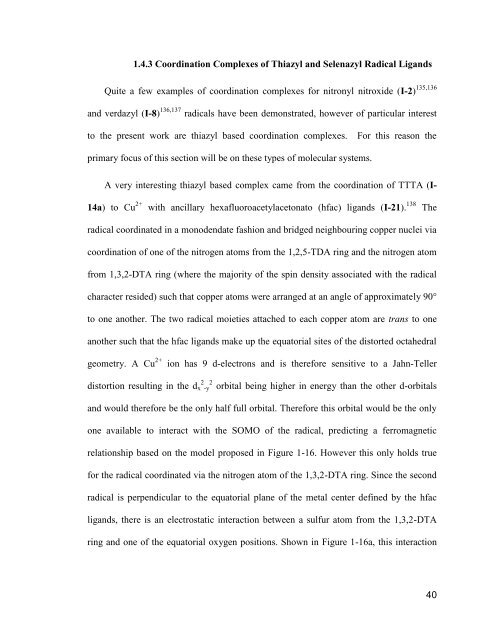1,2,3-Dithiazolyl and 1,2,35-Dithiadiazolyl Radicals as Spin-Bearing ...
1,2,3-Dithiazolyl and 1,2,35-Dithiadiazolyl Radicals as Spin-Bearing ...
1,2,3-Dithiazolyl and 1,2,35-Dithiadiazolyl Radicals as Spin-Bearing ...
You also want an ePaper? Increase the reach of your titles
YUMPU automatically turns print PDFs into web optimized ePapers that Google loves.
1.4.3 Coordination Complexes of Thiazyl <strong>and</strong> Selenazyl Radical Lig<strong>and</strong>s<br />
Quite a few examples of coordination complexes for nitronyl nitroxide (I-2) 1<strong>35</strong>,136<br />
<strong>and</strong> verdazyl (I-8) 136,137 radicals have been demonstrated, however of particular interest<br />
to the present work are thiazyl b<strong>as</strong>ed coordination complexes.<br />
For this re<strong>as</strong>on the<br />
primary focus of this section will be on these types of molecular systems.<br />
A very interesting thiazyl b<strong>as</strong>ed complex came from the coordination of TTTA (I-<br />
14a) to Cu 2+ with ancillary hexafluoroacetylacetonato (hfac) lig<strong>and</strong>s (I-21). 138 The<br />
radical coordinated in a monodendate f<strong>as</strong>hion <strong>and</strong> bridged neighbouring copper nuclei via<br />
coordination of one of the nitrogen atoms from the 1,2,5-TDA ring <strong>and</strong> the nitrogen atom<br />
from 1,3,2-DTA ring (where the majority of the spin density <strong>as</strong>sociated with the radical<br />
character resided) such that copper atoms were arranged at an angle of approximately 90°<br />
to one another. The two radical moieties attached to each copper atom are trans to one<br />
another such that the hfac lig<strong>and</strong>s make up the equatorial sites of the distorted octahedral<br />
geometry. A Cu 2+<br />
ion h<strong>as</strong> 9 d-electrons <strong>and</strong> is therefore sensitive to a Jahn-Teller<br />
2<br />
distortion resulting in the d 2 x -y orbital being higher in energy than the other d-orbitals<br />
<strong>and</strong> would therefore be the only half full orbital. Therefore this orbital would be the only<br />
one available to interact with the SOMO of the radical, predicting a ferromagnetic<br />
relationship b<strong>as</strong>ed on the model proposed in Figure 1-16. However this only holds true<br />
for the radical coordinated via the nitrogen atom of the 1,3,2-DTA ring. Since the second<br />
radical is perpendicular to the equatorial plane of the metal center defined by the hfac<br />
lig<strong>and</strong>s, there is an electrostatic interaction between a sulfur atom from the 1,3,2-DTA<br />
ring <strong>and</strong> one of the equatorial oxygen positions. Shown in Figure 1-16a, this interaction<br />
40

















